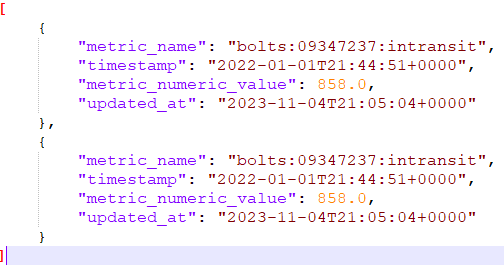Unleash the potential of your data with the magic of JSON files. In modern web development and data interchange, JSON (JavaScript Object Notation) is pivotal in efficiently structuring and transporting data. Its lightweight, human-readable format empowers developers to transmit and store complex information seamlessly. In this article, we delve into the transformative power of JSON, unraveling its versatility and impact on data handling.
Whether you are a seasoned developer or just starting, understanding JSON is essential for navigating the intricacies of data representation. We will explore how JSON facilitates smooth API interactions, enhances data organization, and fosters interoperability across various platforms and programming languages. Get ready to demystify the potent capabilities of JSON and elevate your data management to new heights.
If you’re looking to harness the true power of your data and revolutionize your development processes, this exploration of JSON is your gateway to unlocking its full potential.
Understanding the structure of JSON
JSON, or JavaScript Object Notation, is a lightweight data-interchange format that is easy for humans to read and write and for machines to parse and generate. It is based on a subset of the JavaScript Programming Language, Standard ECMA-262 3rd Edition – December 1999. JSON is a text format that is entirely language-independent but uses conventions that are familiar to programmers of the C family of languages, including C, C++, C#, Java, JavaScript, Perl, Python, and many others. These properties make JSON an ideal data-interchange language. The JSON format is often used for serializing and transmitting structured data over a network connection. It is primarily used to transmit data between a server and web application, serving as an alternative to XML for transmitting data between a server and web application.
Advantages of using JSON
One of the key advantages of using JSON is its simplicity and ease of use. JSON is human-readable, making it easy for developers to understand and work with. It is also lightweight, which means it can be transmitted and parsed quickly, leading to faster data processing. Additionally, JSON supports complex data structures, including arrays and nested objects, making it versatile for representing and organizing various types of data. Moreover, JSON is widely supported across different programming languages and platforms, promoting interoperability and seamless data exchange. Its flexibility and compatibility make it a preferred choice for data interchange in modern web development.
Implementing JSON in web development
In web development, JSON is commonly used for exchanging data between a web server and a client. It enables developers to structure and transmit data in a consistent format, facilitating seamless communication between the front-end and back-end components of web applications. JSON is often utilized in AJAX (Asynchronous JavaScript and XML) requests to retrieve data from a server without requiring a full page refresh. This asynchronous data exchange enhances the responsiveness and interactivity of web applications, providing a smoother user experience. By integrating JSON into web development, developers can streamline data handling and optimize the performance of their applications.
Best practices for working with JSON
When working with JSON, it is essential to adhere to best practices to ensure efficient data management and interoperability. Properly formatting JSON data, using descriptive and meaningful key-value pairs, and organizing data hierarchically are fundamental best practices for creating well-structured JSON files. Validating JSON data to ensure its integrity and using consistent naming conventions for keys contribute to maintainable and scalable data structures. Additionally, documenting JSON schemas and data models facilitates collaboration and understanding among development teams. By following best practices, developers can harness the full potential of JSON and optimize data representation in their applications.
Using JSON in API integration
JSON plays a crucial role in API integration, enabling seamless communication and data exchange between different systems and services. Many modern APIs utilize JSON as the preferred format for transmitting data due to its simplicity and flexibility. By standardizing data representation with JSON, APIs can efficiently transmit structured data, empowering developers to build interconnected and interoperable systems. JSON’s lightweight and human-readable format enhances the accessibility and usability of APIs, fostering a more intuitive and developer-friendly integration experience. Leveraging JSON for API integration streamlines data communication and empowers applications to leverage external services and resources effectively.
Examples of popular APIs using JSON
Several popular APIs across various domains leverage JSON for data transmission and exchange. For instance, the Twitter API uses JSON for retrieving tweets, user profiles, and social network data, enabling developers to seamlessly integrate Twitter functionality into their applications. Similarly, the GitHub API employs JSON to provide access to repository information, user data, and collaboration features, facilitating seamless integration of GitHub’s version control and project management capabilities. Furthermore, the Spotify API utilizes JSON to deliver music metadata, user playlists, and audio features, empowering developers to incorporate music streaming and recommendation functionality into their applications. These examples highlight the widespread adoption of JSON in modern API ecosystems, showcasing its pivotal role in enabling seamless data integration across diverse platforms and services.
Tools and resources for working with JSON
Numerous tools and resources are available to assist developers in working with JSON effectively. JSON editors and validators, such as Visual Studio Code with JSON extensions, provide syntax highlighting, formatting, and validation to streamline JSON file creation and editing. Online JSON viewers and parsers offer convenient platforms for visualizing and analyzing JSON data structures. Additionally, JSON schema generators and validators help ensure the integrity and compliance of JSON data with predefined schemas and standards. Libraries and frameworks, including Gson for Java and Newtonsoft.Json for .NET, offer robust support for parsing and serializing JSON data within programming languages. Furthermore, online documentation and community forums provide valuable insights, tutorials, and best practices for leveraging JSON in development projects. By utilizing these tools and resources, developers can enhance their proficiency in working with JSON and optimize data management processes.
JSON vs. XML: A comparison
While both JSON and XML are widely used for data interchange, they exhibit distinct characteristics and are suited for different use cases. JSON is known for its lightweight, human-readable format, making it ideal for transmitting and storing structured data in web development and API integration. Its simplicity and compatibility with modern programming languages contribute to its widespread adoption in contemporary software development. On the other hand, XML (eXtensible Markup Language) excels in representing hierarchical data and supporting complex document structures. It is commonly used in data exchange and document markup, particularly in enterprise applications and data representation. XML’s extensibility and schema validation capabilities make it well-suited for scenarios requiring stringent data validation and transformation. While both JSON and XML have their strengths, the choice between them depends on the specific requirements and context of the data interchange scenario.
In conclusion, the power of JSON in data representation and interchange is undeniable. Its simplicity, versatility, and compatibility make it a fundamental tool for modern web development, API integration, and data management. Understanding the structure of JSON, harnessing its advantages, implementing best practices, and leveraging it in API integration are essential considerations for developers seeking to optimize data handling and interoperability. By exploring examples of popular APIs using JSON and utilizing dedicated tools and resources, developers can enhance their proficiency in working with JSON and elevate their development processes. While JSON and XML each have their distinct characteristics and use cases, JSON’s lightweight and human-readable format positions it as a preferred choice for transmitting and organizing structured data in contemporary software development. Embracing the transformative power of JSON is a gateway to unlocking the full potential of data management and revolutionizing development practices. As the digital landscape continues to evolve, JSON remains a cornerstone of efficient data representation and exchange, empowering developers to unravel the magic of data with JSON files.
The power of JSON is truly transformative, and its impact on modern data handling is profound. By mastering the intricacies of JSON, developers can unlock new possibilities for data representation and exchange, paving the way for seamless interoperability and enhanced user experiences. As the digital ecosystem continues to evolve, JSON will remain a cornerstone of efficient data management and communication, shaping the future of web development and software integration. Embrace the potential of JSON and embark on a journey to unravel the magic of data with JSON files.


